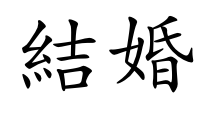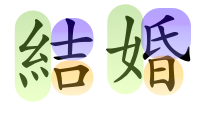
Using Radicals to your Advantage
Hopefully you've taken some time to become familiar with the different radicals commonly found in kanji. You may recognize only a few or a lot, depending on your experience with kanji. Let's take a look now at how to use kanji radicals to make kanji study more efficient.
Learning New Kanji
Imagine you come across this beast:

Looks pretty intimidating to someone seeing it for the first time. If that's you, simplify it. Take a look at the radicals that make it up.

Chances are, if you're a second or third semester student, you'll recognize all but one of the radicals. That makes it much easier to learn! All you have to remember for each kanji is how the radicals fit together.
Using radicals to learn strokes is only part of the story, though. They can also be used (sometimes) to clue you in to the meaning of kanji.
Let's look again at 働 from the previous lesson.

Let's decipher the meaning of each radical:
- Green: Person
- Blue: Heavy
- Orange: (Physical) Strength
- Blue & Orange : Move
Modified radicals offer simple clues, too. It's a safe bet that anything with the modified 水 radical has to do with water or liquid, for example.
Retaining Kanji
Memorizing kanji for a quiz is one matter; retaining that knowledge into the next semester is another. We can't expect to do so without daily practice, of course. Learning kanji by radicals, though, may be helpful to you in terms of retaining that knowledge longer.
That's the basics of kanji radicals; the rest is up to you. Check the final page for helpful items and links.